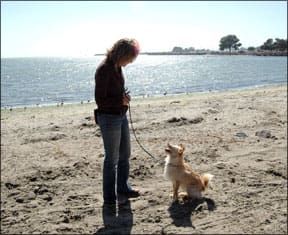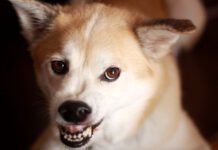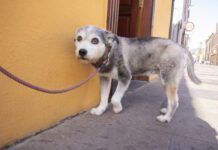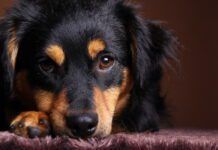You’ve probably heard about people who wash their hands repeatedly until the skin wears off, who pull out their hair until they’re bald, or return home, time after time after time, to make sure the stove is turned off. These are obsessive-compulsive disorders (OCDs).
Sad to say, OCD behaviors aren’t confined to humans; dogs get them, too. Oh, you won’t see your dog worrying about whether the stove was left on, nor will you catch him washing his paws repeatedly in the sink. Dogs have a whole set of potential OCDs all their own, specific to canine behavior. Canine OCDs are just as capable of destroying a dog’s ability to function as human OCDs are capable of affecting human lives.

What is OCD?
MedicineNet.com says this about OCDs:
“OCD is a psychiatric disorder characterized by obsessive thoughts and compulsive actions, such as cleaning, checking, counting, or hoarding. One of the anxiety disorders, OCD is a potentially disabling condition that can persist throughout a person’s life. The individual who suffers from OCD becomes trapped in a pattern of repetitive thoughts and behaviors that are senseless and distressing but extremely difficult to overcome. OCD occurs in a spectrum from mild to severe, but if severe and left untreated, can destroy a person’s capacity to function at work, at school, or even in the home.”
The last thing you want is for your dog to develop an OCD. The more you know about them, the better armed you are to prevent OCDs, and the better able to recognize and take action sooner rather than later – a critically important element of a successful behavior modification program for OCDs.

Are Dogs Really “Obsessive”?
There is some disagreement among animal behavior professionals about applying the term “obsessive” to canine behavior. The “anti-s” declare that the term “obsessive” refers to the dog’s thoughts, and because we can never really know what a dog is thinking, it’s therefore inappropriate to use the term in reference to dog behavior; we should simply call it “Canine Compulsive Disorder.” The word “compulsive” refers to the dog’s actions, which we can clearly see, so it’s okay to use that term in relation to dogs.
Those who favor using the term “obsessive” argue that we know a dog’s brain is similar in many ways to a human’s, albeit with a smaller cortex, and the observed compulsive behavior patterns are so similar to human OCDs that it only makes sense to call it obsessive, even with regard to dogs. A growing number of behavior professionals share this opinion – as do I – and so “Obsessive Compulsive Disorder” is becoming an increasingly used term in dog behavior work.
Noted veterinary behaviorist Dr. Karen Overall suggests that as much as two to three percent of our canine population may be afflicted with OCD. She also identifies it as one of the most difficult canine behavioral disorders to successfully treat, and emphasizes that genetic, environmental, and neurochemical/neurophysiological elements all come into play.

Certain breeds have a clear genetic propensity for specific OCDs. Cavalier King Charles Spaniels are prone to fly-snapping, and shadow-and light-chasing; Doberman Pinschers tend to flank-sucking and self-mutilation from licking; a high percentage of Golden and Labrador Retrievers seem to suffer from pica (eating inappropriate objects); and several of the herding breeds are likely to demonstrate OCD spinning and tail-chasing behaviors (see “OCDs and Breed Predispositions,” below). It’s a good idea to research your own breed thoroughly, so you can be especially watchful for telltale signs of any that may plague your breed.
In addition to the genetic component of OCD behavior, environment plays a significant role. OCDs most often emerge in young dogs, between 6 to 12 months, in dogs who have a genetic predisposition to the behavior, when subjected to environmental stressors that trigger the onset of the behavior. Dogs who may be genetically prone to a behavior may dodge the OCD bullet if they avoid being significantly stressed during this period. Or maybe not.

Early Signs of Canine OCD
The early sign of any OCD is the occasional performance of a behavior out of context. It’s normal for a dog to chase a real fly; it’s not normal for him to start snapping at things in the air that you can’t see. Because well-practiced OCDs are heartbreakingly difficult to modify, it’s critically important to identify and modify OCD behavior in its early stages.
I’ve had two different clients who had dogs with fly-snapping behavior. One was a Bernese Mountain Dog, the other a Cavalier King Charles Spaniel. Both are on the list of breeds at high risk for this behavior. The Berner’s owners, already Peaceable Paws clients, identified the behavior at its onset and we immediately took appropriate steps to modify the behavior. Leo eventually stopped snapping at imaginary flies. The Cav’s owners also identified the behavior at onset and contacted the breeder, who told them, “Oh, some Cavs just do that. His sire and several of his littermates do it, too.”
By the time Widget reached the age of 18 months and his owners sought professional behavior assistance, the condition was severe. When I visited their home I found a dog in misery, unable to be in a lighted room for any length of time without becoming extremely anxious, eventually snapping nonstop at his invisible tormentors. He could escape his mental torture only by running into the darkened dining room and hiding in his crate. This poor dog required extensive treatment with psychotropic drugs as well as a behavior modification program to bring the debilitating behavior under control.

Our own Cardigan Corgi, Lucy, exhibited tail-chasing behavior in the shelter before we adopted her, both in her kennel and during the assessment process. Note that tail-chasing and spinning are seen disproportionately in the herding breeds. Fortunately for us and for her, Lucy was young when we adopted her (six months). Simply removing her from the stressful shelter environment and providing her with large daily doses of physical exercise resolved her behavior.
Ben, a four-month-old Golden Retriever client in Monterey, was also treated successfully, simply by having his owners remove all reinforcement (getting up and leaving the room) the instant the pup started to chase his tail. His spinning behavior ceased within a month. A Standard Poodle client I worked with in Santa Cruz was not so fortunate. At age three, Giselle’s spinning behavior was well-established; her owners couldn’t even walk her on leash because of her nonstop spinning anytime she was in the least bit stimulated. Like the Cavalier, she required extensive pharmaceutical intervention.

The following are the most common OCD behaviors seen in dogs:
Lick granuloma: Also known as Acral Lick Dermatitis or ALD, this disorder presents as repetitive licking of the front or hind legs, ultimately causing a bare spot, then an open sore, sometimes causing systemic infection. In extreme cases, a limb may need to be amputated.
Light-Chasing
(Includes shadow-chasing.) Likely related to predatory behavior, light-chasing is characterized by staring, biting at, chasing, or barking at lights and shadows. This behavior is sometimes triggered by an owner playing with the dog with flashlights or laser lights.
Tail-Chasing/Spinning
Also perhaps a displaced predatory behavior, tail-chasing often starts as an apparently innocuous, “cute” behavior that is reinforced by owner attention. Only when it attains obsessive proportions do many owners realize the harm in reinforcing this behavior.
Flank-Sucking
A self-explanatory term, flank-sucking behavior is likely a displaced nursing behavior. Similarly, some dogs may suck on blankets or soft toys – behaviors that can be equally obsessive, but are less self-destructive.
Fly-Snapping
No, this one doesn’t refer to dogs who chase real flies – that’s a normal behavior; the OCD version of fly-snapping involves snapping at imaginary flies. Dogs who exhibit this behavior may appear anxious, apparently unable to escape their imaginary tormentors.
While some fly-snapping may be seizure-related, a significant percentage of sufferers don’t demonstrate behaviors typical of seizure activity, and those episodes are characterized as true OCD behaviors.
Pica
While many dogs are happy to eat objects that humans consider inappropriate, dogs with pica do so obsessively. Pica induces some dogs to obsessively eat and swallow small objects such as stones, acorns, and twigs, while others ingest large amounts of paper, leather, or other substances. Pica can cause life-threatening bowel obstruction.
It’s important to note that dogs who are prone to one obsessive compulsive behavior can easily adopt another. I firmly prohibited my husband from playing with Lucy with a laser light, or water from the hose, knowing full well she’d delight in these activities. We didn’t need light-chasing on top of tail-chasing! Ben, the tail-chasing Golden pup, had a more serious OCD problem: he was obsessive about eating pebbles, small sticks, and acorns. At the tender age of four months he had already undergone one emergency surgery for intestinal blockage, and had to wear a muzzle when he was outside, on leash or off, to prevent a recurrence.
For this reason, simply suppressing the behavior through punishment is a dangerously inappropriate approach. Not only does the punishment add stress to a behavior already triggered and exacerbated by stress, it heightens the risk of having the dog transfer to a new OCD. Far better to approach an OCD modification program more scientifically.
Modifying OCD Behavior
There are five key components to most successful OCD modification programs:
1. Increase Exercise
A useful part of almost any behavior modification program, exercise relieves stress and tires your dog so he has less energy to practice his OCD behavior. While physical exercise is hugely important, don’t overlook the value of mental exercise for relieving stress and tiring a dog mentally. (See “A Puzzling Activity,” June 2008, and “Mind Games,” October 2004, for more information on how to keep dogs busy.)
2. Reduce Stress
This is an important and obvious step, given that OCDs are triggered and exacerbated by stress. You will need to identify as many stressors as possible in your dog’s life. Have the whole family participate in making a list of all the things you can identify that cause stress for your dog – not just the one(s) that appear to trigger the obsessive behavior.
Then go down the list identifying any you can simply eliminate (i.e., shock collar for that evil underground shock fence) and commit to removing those from his environment. Next, mark those that might be appropriate for counter-conditioning – changing his opinion of them from “Ooh, scary/stressful!” to “Yay! Good thing!” (See “Fear Itself,” April 2007).
Finally, try to manage his environment to at least reduce his exposure to those that can’t be eliminated or modified.
3. Remove Reinforcement
All too often, owners mistakenly think obsessive behaviors are cute or funny. They reinforce the behavior with laughter and attention, and may even trigger the behavior deliberately, unaware of the harm they’re doing. When the behavior becomes so persistent that it’s annoying, the dog may be reinforced with “negative attention” when the owner yells at him to stop doing it.
As in the case of Ben, the Golden pup, removing reinforcement by having all humans leave the room can work well to help extinguish an OCD in its early stages.
4. Reinforce an Incompatible Behavior
This was also an effective part of Ben’s modification program. When the puppy wasn’t chasing his tail, his owners used a high rate of reinforcement for calm behavior, especially for lying quietly on his bed. Also, look for other calm behaviors to reinforce during otherwise potentially stimulating moments, such as sitting quietly at the door for his leash rather than leaping about in excitement over the pending walk.
5. Explore Behavior Modification Drugs if/when Appropriate
With persistent and well-practiced OCDs, referral to a qualified veterinary behaviorist for consideration of pharmaceutical intervention is nearly always imperative. The selection, prescription, and monitoring of the strong, potentially harmful psychotropic drugs used for modification of difficult behaviors requires the education and skill of a licensed veterinary professional.
You can find veterinary behavior professionals at American Veterinary Society of Animal Behavior or American College of Veterinary Behaviorists.
If some of this information has alarmed you – good! Obsessive-compulsive disorders are alarming.
If your dog, or a friend’s, is showing early signs of OCD behavior, we want you to take it seriously, and intervene immediately, in order to prevent the behavior from developing into a debilitating disorder. Dogs like Lucy, Ben, and Leo can lead full and happy lives because steps were taken early to prevent their behaviors from becoming extreme.
If your dog already has a severe obsessive compulsive behavior, do something about it now. Dogs like Widget can lead quality lives because their owners care enough to find solutions for difficult behaviors. Make the commitment to find the help you need so you and your dog can have a full and happy life together.
Pat Miller, CPDT, is Whole Dog Journal’s Training Editor. Miller lives in Hagerstown, Maryland, site of her Peaceable Paws training center. Pat is also author of The Power of Positive Dog Training; Positive Perspectives: Love Your Dog, Train Your Dog; Positive Perspectives II: Know Your Dog, Train Your Dog, and the brand-new Play with Your Dog.







Are these OCD behaviours possibly caused by inbreeding? I’m concerned about a 9 month old golden that ‘mouths’ enough to break the skin and she will lie on her side and frantically paw the air until she is interrupted, or she will dig until she has a hole in the wooden flooring. She jumps up and causes facial scratches and is heavy enough to push you down if you are caught unaware. These are all behaviours that
I find frightening and I have never had to deal with in any dog I have owned before. She has just been spayed and gets lots of exercise on long hikes and plays with other dogs but only stops the OCD when she is exhausted. She seems to understand everything you say to her and is extremely smart, but repetitive in her activities. She is gradually trained, but has to be constantly watched for these weird behaviours. Is there
anything a vet can tell us, or is it going to go on until she either outgrows it, or is on drugs?
Yes, that and more can be caused by irresponsible breeding. Dog breeders too often think they’re geneticists. They’re usually not. She sounds miserable, seriously. Eating through a wood floor? Mouthing through her own skin?
Geez, see a vet, hon! And sooner, rather than later.
A good vet will point you in the right direction. Always first rule out the possible physiological causes, tumors and the like.
Think she’s getting enough exercise and stimulation? Double it. Get her into agility trials or treibballing.
What’s she eating? Anything commercially produced? Ever read the labels? Yikes!
All things to talk over with the vet and think about while any meds prescribed get a chance to start working. Think of them as supplements that are highly likely to help her, rather than some sort of defeat. Training for human(s) and dog is just as important.
Set realistic goals. Work with your family, vet, behaviorist, etc. on that.
Good luck with your hunting dog. Thank you for spaying.
I have a chow/lab mix who has always licked a lot, but it’s recently gotten out of control. You can’t walk through a room without him licking you as you walk by, and he licks his paws all day long.
He’s older, he’s 10 and it’s gotten noticeably worse over the past 6 months. My guess is that it’s pandemic related, as silly as that sounds!
He’s a guard dog at hear who cares, to an extent that it’s probably not healthy for him, that his family is safe. This has been exacerbated over the years as our family has grown with young children. I believe that he’s MORE stressed with everyone home all day because he’s worrying all day. I think having time without us have him downtime where he didn’t have to be so concerned about what we were all doing. Now, if I get up from my desk to go in the hall, he bolts up barking ready to protect us from whatever the noise may be.
Any advice for helping an older guy?
Can laser pointer syndrome be reversed or can we take actions to relieve the chase on the carpet – dog minder played the laser game with him for 2 weeks and no he constantly runs up abs down the carpet looking for something or barks all the time at shadows